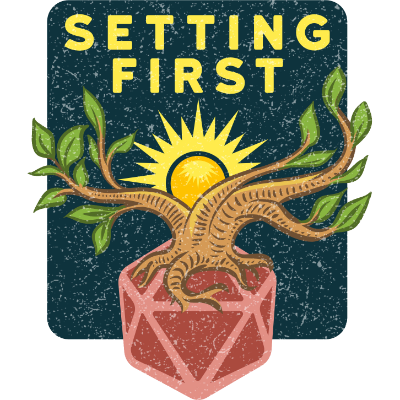
Before the Internet gave us the pleasure and torture of instant connectivity, I ran many an adventure with the help of the US Postal Service.
If you’re like many experienced gamers, you’ve been involved in at least one campaign that disintegrated due to one or more of the players moving out of the area. It certainly is a pity to give up an exciting campaign, and it’s especially frustrating when the players mesh particularly well. That’s exactly what happened to me and two longtime gaming friends. Our Shadowrun campaign fell victim to moves that took two of us from California to different cities on the East Coast. This article is about how we overcame that obstacle, and how you can do the same.
By the time we became geographically separated, we had run through perhaps a dozen full-length adventures and a host of smaller “off-the-cuff” runs. The player characters were well-developed and had by then made several enemies as well as allies. Not wanting to let all that work go to waste, we began sending each other short stories involving the player characters and the other important figures in the campaign.
Over time, we culled through what worked and what didn’t, and came up with a standardized method for running these “postal adventures.” The GM kicks off the adventure by writing a story that establishes the characters involved, the situation they are in, and the key non-player characters. Often the best way to do this is string together a series of small sub-adventures, each one describing or described from the point-of-view of a particular character. At a critical point in the story, the GM “writes herself out,” by establishing a cliffhanger ending.
The GM then sends a copy of the story to each player. The players call or write each other and establish who will determine each particular thread of the story. One of the players collects the sub-stories and works it all into a full completion of the GM’s story.
An example might make this clearer: Erik the GM comes up with a story involving Jamie’s character Big Gulp, and John’s character Eschdahal. The story involves Big Gulp and Eschdahal in a run to hunt down a particularly nasty corporate spy that Ares wants to be rid of. Erik describes how the two characters are contacted and hired, the initial encounter with the corporate spy, and how the PCs set up an ambush for the spy. To set up the cliffhanger, he writes in that the PCs are discovered as they lay in wait for the spy. In fact, the spy has a mage partner who covers him.
At this critical juncture in the adventure, the GM stops writing, and sends the story to Jamie and John. Consulting briefly by phone, Jamie and John decide on a course of action, and resolve who will write what. Jamie writes up a sub-story about how the two PCs are momentarily stunned by the mage’s spells, but they manage to escape with some physical damage. He sends the sub-story to John, who dovetails the final ending, wherein the PCs embark on a scorching car chase through Renton and wind up killing the spy. John then sends the completed story to Jamie and Erik.
This type of adventure contains obvious pitfalls. The most obvious is that anyone could kill off a PC at any time if he so desired. The best way to resolve this is to agree that no one can kill off a PC or even a major NPC without everyone’s approval. In order to balance this, it is advisable to keep the rewards down as well.
The GM should be the final arbiter of rewards, be they treasure, experience, or other gain. Depending on the maturity of the players, the GM can either declare that he is the sole rewarding authority, or he can allow players to give their characters rewards, contingent on approval. If the GM doesn’t like a reward, he can always engineer it so that the character looses it somehow in the next adventure.
Remember that the adventure has to make sense in the game world. If the participants start taking liberties with the rules, pretty soon no one will have a common frame of reference. For example, in the Shadowrun universe, it is impossible for a magician to cast a spell at a target he can’t see. If Eschdahal the Mage starts blowing opponents off the map while blindfolded, the storyline loses credibility.
The “postal campaign” is not intended to be a full replacement for a standard FRP, but it offers the advantage of continuing the process of character and game world development. Rather than just saying, “Well, your characters have been keeping busy with a few runs since we last played,” the GM and the players can set the stage for standard adventures before hand by mail.
There are a few key points to keep in mind, however. All participants must have a firm grasp on the rules being used, the characters involved, and the game setting. This requires a shift in the standard relationship between players and GM. First, the GM will have to be more forthcoming with information. Many GMs like to keep control of their game world. They put in the effort to fleshing it out, and they don’t want players to mess it up too much.
In a “postal campaign,” the GM has to loosen the reins, let the players in on what’s going on. This can be a fine line. The GM needs to give the characters more to chew on, without informing them of what she has planned next. One method is for the GM to write up or copy specific pieces of information from her own notes or published sources, and send these to the players. For example, in our campaign, the GM sent the players information on San Francisco, leaving out key information that would factor into the first part of an adventure.
The players, in return, have to exercise restraint. With all this new freedom of information, they must remember that the GM has worked hard to establish the world in which the characters operate. The major NPCs are often well-loved creations, and shouldn’t be run over rough-shod. The players also have to understand and nurture the role-playing goals of the other players. For example, it is in poor taste for Jamie, whose character is an Ork, to write a story wherein John’s mage becomes slavishly devoted to all Orks he encounters.
The emphasis, in our experience, tends toward character interaction and motivation rather than combat. This is because fleshing out the characters is the primary goal. During the course of postal adventures, the PCs will encounter combat, but the players should avoid getting too wrapped up in going into detail with every combat situation. For one thing, writing combat narratives can be quite difficult and time consuming.
Role-playing is what it’s all about. The “postal campaign” serves as a tool for the players and GM to keep a campaign moving in the right direction. While not a panacea for the hated geographical separation, it has provided us with a lot of opportunity to role-play many of the areas that get neglected in a standard campaign.
Today I was sifting through some boxes of old gaming books and ephemera from long-dead campaigns, when I came across the delightfully archaic post you just read. It was printed on four sheets of paper, neatly stapled together and sitting atop a pile of printed “postal campaign” adventure write-ups. My best guess is that I drafted it in 1993 or ‘94.
Was I planning on sending it into a publication like Challenge or White Wolf? Possibly. I can’t recall. Regardless, it offers a narrow glimpse back at an era just before the Internet wiped out those magazines and changed how everyone played FRPs tabletop RPGs, whether at the table or on opposite ends of the country.
Image Credits
« Lucy » skeleton (AL 288-1) Australopithecus afarensis, cast from Museum national d’histoire naturelle, Paris is used under a CC-BY-2.5 license.
Ω

